Alphabet City
| Description | Submit An Entry | Standings | Final Report |
The Task
Play a solitaire version of Scrabble.
Scrabble is a board game in which players alternate placing letters on a 15 x 15 grid, forming words crossword-style and collecting points for each word. The rules for this solitaire version are the same as the rules for a conventional multi-player game, with some modifications (see below). If you aren't familiar with the rules for regular Scrabble or with Scrabble terms like premium square, tile, rack, bag and main word you might want to check out either or both of the following references before reading on:
- Scrabble on Wikipedia
- Official Scrabble Rules
You might also consider downloading the free Words With Friends app to your smartphone. WWF is essentially a Scrabble clone.
If you are familiar with the rules of Scrabble but don't have a freakishly eidetic memory, you'll find the following information necessary:
-
The point values of the 26 letters:
Letter A B C D E F G H I J K L M N O P Q R S T U V W X Y Z Point Value 1 3 3 2 1 4 2 4 1 8 5 1 3 1 1 3 10 1 1 1 1 4 4 8 4 10 -
The locations of the premium squares (Double Letter,
Triple Letter, Double Word & Triple Word):
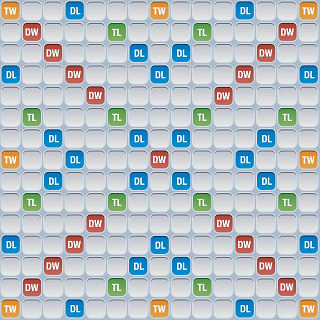
-
The bonus for playing all 7 tiles from your rack in
a single play (a "bingo") is 50 points.
- The list of acceptable words is here. For those who care about such things, this list is the Enhanced North American Benchmark LExicon, also known as ENABLE.
The modifications that convert the rules for a 2-player game to those for this 1-player game are:
- At the start of the game you are told the order in which tiles will come out of the bag.
- Since there is no second player, there is no alternating of turns. You continue to play words until either there are no tiles left or you can't make a play.
- You can't exchange tiles in your rack for other tiles.
- When you've made your last play, the values of the tiles left in your rack and in the bag are subtracted from your score.
The Contest
We will supply you with 26 different bags of tiles, labeled A through Z. You are to play a solitaire game of Scrabble with each of these bags, attempting to score as many points as possible. For each of these games, submit (see How to Enter, below) a list of the plays you made.
You can submit more than one game for the same bag, but if you do we count only your best game. There is no penalty for submitting multiple games for the same bag.
Note that on other pages of this site, for consistency across all contests, we refer to a bag as a problem and to a game as a solution to that problem.
These are the 26 bags of tiles. The tiles within each bag are listed in the order in which they will be drawn. Blank tiles are represented by a question mark.
A: AIOIETPRTIRDDGNEOEDERUCERAAOIOEEFAHASZENKBBSTLRIURMSC?SFGLQETAIGEOYEAOOT?PVNUMLIJVWODNAIIAXLNEWNYUHT
B: BMLUNNRESETO?AOSADTJUOWALITSNTEEDUIRAEAWECNBDTECPIOAYOSINKGERVOYAMIEPTRQEXFRAUVLFOEGEDIIA?HLZOHIIRGN
C: CHHBUERLTJ?PFEXONFADERNRAZOVAEEIOVISWDTPYAEYIN?GENNDILKITOATMSIOEQAITCRILEDEOOGNWGSMRAUALUUEATEBROSI
D: DEHERIOEGDPYOERICIAGFSMYUA?ENAEUFUTBONTRJAWLNITEEINMZNSIRIIPHISE?SQREOTOLEVATAGNCTABORWOAKLDDEOAUVLX
E: E?AVCDNGTIEANJSSCOTLEIREMAEBDPOTLANIEAIWZDTSXRUIPEOONEGUFVIBUMEERIOLWIOAGYNDQ?ESATKYAUHHROEIRFAOTNRL
F: FUOEEBS?ORI?ITARWIDUTATMETAAZQLYEEIMONLOIAVJUGFNAIRTOVEEACYIBPXSEHPEILDISLNRCGOUNHANWOEESDKONARRDEGT
G: GZASFIOIDANNTAAOURMISLN?ONXDDAEEAOEREUFVUGO?HRIMWEOERKETIADRILECTIOEUIIANQNOYPSVEHEWJALREGCBTSPTBTLY
H: HYAIEOEINE?LSIACATLTBEHMERWJWVOFENNRAAILTRQSSBNOEVUGDRCDOOENRUIORPEFYGAALAAKOOTDEIEDEIITPNGTZXU?IMSU
I: IEOUOSNYHCJDEIA?WTTDEQDAZCXEABENAIUTALH?SANWLIIEANELIALREOUOSIUGVTESNEVNORGEFFOPRTEOTRDYRGOIMPBKAIMR
J: JVUQENNWNDEARLAIOUEABZDIREAEBAATFNYOMEAIOT?HRRTAFEEETPOLSNADNIUMEKVGOOXOUWIG?SPYICTSSRTIOHLRCLIEIEDG
K: KHEETWIOEWTMO?OIIACEDORF?VJASTRDNEBNOURQHEASOAYIODIEAIIUNZEULITLCRXGTARMEISVNYNUTAELGNADRESLOPBPEFGA
L: LTUDELNVREITEOSSYBEUNRFA?SOI?DRIHETNUXOMEGPOWACOAIERNTAOJTDIRAVLIWHARDTAGNNEALBUMZGISAPIEEECQIOEKFOY
M: MWLTAFEUEIETAIAXYAOTONNCRFEWAEI?DPEEICIREHILKRZNSJOIDDUYLIBSAHTAAIRNETOUQTOLEDR?GSEPOAUBSGVVRNOOGEMN
N: NARNNMSAAPHCOERRUHAOOIIIEIEKTTAGODUAFOITEDSFDYOOEEGRJENDSIGCLIEITAPQLUME?LRRVBINXTETOL?EWVEANBUZYSWA
O: OETZNIIASEEUHDWDMCTRGOIQDIUNAOOEAEPTWNHENYRINOEDPVRLIIIATATCMV?BNASALBFYSOEIUXELERTEUARORKASOFJL?GGE
P: PEEEENELAJCOOIUNSFIROIEESTBADVMIYWHTRXOULZEGATIECWN?OINE?UMIIBGDVRORAASSOLEPDUATHTREGLQNFATOIAKDRANY
Q: QDSEEOEUUHONGLWRA?ELITRDLNXRMADEZCANYOEOTTAIBVYAEGORNHBTINROPIFSDIMEIGTITNOKSEALOVICFISRAEAJ?UWEPAEU
R: ROTFMAATIAIAGJLAASP?GUUECTNRRIOLRVMYVGASNOXEFDIIDHSOTWZTRNEOIEBAIYEIULDOPSHNWKR?EALENUNOQECEDEEEOTIB
S: SQOJDGAHIAAIBXCYCII?DERLUZSNI?IDNNMRGPMELEKOFGYLOWETVNNOVEOBOLUFRUTNHEOETAITSAAOWEAIRIDUATREAESTEERP
T: TCWIMNVOTAOKRANEZVGIEFOWOURFNXDAOHAIL?GEGEALTRRESICHLAENM?TOSNAUTNSEYDQYJBAAEEDSEIOERTOPDLUIEPIRBIUI
U: UFTUNTSIAR?COZTEMGRJIRMKRDEHLVIAEGEAXIEDAO?OOPTPBBFNYORARHCINIWEEWTGOSEAANLSTUUAELEINYAONEEOIVLQISDD
V: VRETPMPEVAAEEHTCOTENMEIIUWSIOZGARILOGAEIFEOWA?DQAYYIDONOFTXRRELURANSTCOLKTEENJGUOBIR?USANLDHAIIBNEDS
W: WAAVROAYAIIERNTTRIINOXOEPUOLHLGTITAEADDERBOSEROT?ONDECL?GTEUVILJZNQSKMSIEEUIEWAUCSINPDGEEARBYFFHNAOM
X: XPENAHAEAEWTLTRQDVNJTDHIR?SMUTOIITMNEAZETERBOUWROIOERALRFUSBKIECLLEOEDIAYFNOGEOUA?SIAINIESDGCYPGVNOA
Y: YEEAWRUVENLDSSTTZUEABOTIROOAAAONRIMDQFGDRXJGOYLLITTRFITEGSEE?SPBURHHEOANLAECDNOUCENEIWIIMEP?AAIVINKO
Z: ZQSELYRKALAFEBVFRUSHND?UE?REAAEITIGNALOURRAVGOTTXSOOYDMPOSAIEIIAEOIPRHEEETNTCBNMDUGDIJIOWLTCIEOENWNA
See The Scoring System, below, to learn how we determine the winner.
The Prizes
First prize is your choice of any item from Bathsheba Sculpture worth up to $500. The following pages show representative items in this price range:
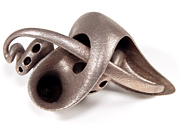
Whelk |
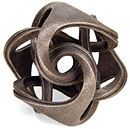
Ora |
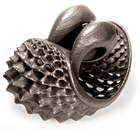
Tuskshell |
Second prize is your choice of any item from Bathsheba Sculpture worth up to $100. The following pages show representative items in this price range:
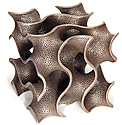
Gyroid |

Borromean Rings |

Klein Bottle Opener |
How to Enter
Paste your games into the large box on the Submit page and click the Submit Entry button. Format your games as follows:
- An individual game consists of a bag name, followed by a colon, followed by a comma-delimited list of plays. The format for a play follows standard Scrabble notation and is described below.
- Submit multiple games (for different bags) in a single entry by separating them with semicolons. Do not put a semicolon after your last game.
- Include spaces and line breaks anywhere (well, anywhere reasonable) to improve readability.
For example, to submit a game for Bag B consisting of just 9
plays, you might enter the following. (Note that this game
scores very few points because it leaves so many unplayed
letters in the bag.)
B:
H6 BURN 12,
10E LETS 13,
G4 ExAM 19,
4D NOTED 16,
E3 WOO 12,
D1 LOAN 10,
1A JAILS 36,
F6 TENSE 19,
G9 UTTER 11
As you can see, the notation for each play has 3 components:
- the coordinates of the starting letter of the main word (rows are labeled 1-15, columns are labeled A-O; specify the row first if you are playing the main word horizontally and the column first if vertically),
- the main word (where playing a blank tile use a lower case letter — elsewhere use upper case), and
- the number of points you expect to get for the play — this information is optional but, if you include it, it will be validated.
The Scoring System
We give a raw score to each game you submit. The raw score is the sum of the points awarded for each play in the game less the point values of unplayed tiles in your rack and in the bag. For instance, the example game from the How to Enter section above would receive a raw score of 8 — that's 148 points for the 9 plays, less 140 points for the unplayed tiles.
Each time you submit a game we will merge it with your prior games, if any. The result will be a virtual entry containing your best games for each of the 26 bags. We will give each of these 26 games a subscore from 0 to 1 (see next paragraph) and their sum will be your contest score.
We calculate the subscores for individual games as follows. If your game has the highest raw score that was submitted for that bag, we give it 1 point; otherwise we give it only a fraction of a point. The fraction is the game's raw score divided by the highest raw score submitted by anyone for that same bag.
Let's walk through a simplified example. Suppose that we modify the contest by asking you to submit games for only 3 bags: A, B and C.
Further suppose that we have 3 entrants (Bella, Edward and Jacob) and that their best games have raw scores as follows:
| Bag A | Bag B | Bag C | |
|---|---|---|---|
| Bella | 157 | 260 | 513 |
| Edward | 104 | 313 | 213 |
| Jacob | 206 | 208 | 418 |
We note the highest raw score for each game, as follows:
| Bag A | Bag B | Bag C | |
|---|---|---|---|
| Highest Raw Score | 206 | 313 | 513 |
Finally, we compute the subscores and contest score for each entrant:
| Bag A | Bag B | Bag C | Contest Score | |
|---|---|---|---|---|
| Bella | 157 / 206 = 0.7621 | 260 / 313 = 0.8307 | 513 / 513 = 1.0000 | 2.5928 |
| Edward | 104 / 206 = 0.5049 | 313 / 313 = 1.0000 | 213 / 513 = 0.4152 | 1.9201 |
| Jacob | 206 / 206 = 1.0000 | 208 / 313 = 0.6645 | 418 / 513 = 0.8148 | 2.4794 |
If two entrants have the same contest score, we break the tie by giving preference to the entrant whose last improvement was submitted least recently.
Getting Your Questions Answered
First, check the FAQ section below. If you can't find the information you need there, send your question to the discussion group. If your question is of a personal nature, and not of general interest, send an email directly to Al Zimmermann.
The Discussion Group
If you think you might enter the contest, you should join the contest discussion group. You can join either by sending a blank email here or by visiting the group on groups.io. The discussion group serves two purposes. First, it allows contestants to ask for clarifications to the rules. Be aware that sometimes these requests result in changes to the rules, and the first place those changes are announced is in the discussion group. Second, the discussion group allows contestants to interact with each other regarding programming techniques, results and anything else relevant to the contest.
My Lawyer Would Want Me To Say This
I reserve the right to discontinue the contest at any time. I reserve the right to disqualify any entry or entrant for any reason that suits me. I reserve the right to interpret the rules as I see fit. I reserve the right to change the contest rules in mid-contest. In all matters contest-related, my word is final.
Frequently Asked Questions
Can teams enter the contest?
Collaboration is allowed. However, only one of the collaborators may register. If two contestants are found to have collaborated, even if this occurred before one or both registered, both will be disqualified.
What information about my games can I share in the discussion group?
There are two types of information that you are forbidden to post. The first is specific games. The second is code. You may post scores, so if you want to tell everyone that you got a raw score of 2713 for Bag W (whether true or not), go right ahead. You may also discuss the algorithms you are using.
How can I find out what my individual subscores are?
You can't. I know this is frustrating, but it's a long standing policy that isn't going to change. Over the years it's been hotly debated in the discussion group and the contest administrator appears to have very strong feelings on the matter. You're going to have to learn to live with it. And I'd think twice before raising the issue yet again.
Can I enter the contest more than once, using different accounts?
No. Submitting entries from more than one account is not permitted. In fact, just having more than one account is against the rules.
After I submit a game, the scorer shows me the game's "canonical representation". What is that?
After the scorer calculates your raw score it rotates your plays (if necessary) to ensure that the first play is horizontal, thus creating a standard representation for your game. Having canonical representations makes it easier to notice when two seemingly different games are fundamentally the same.